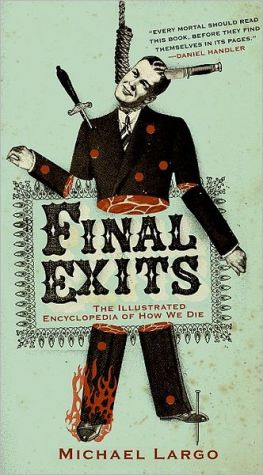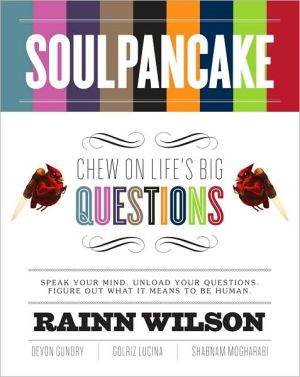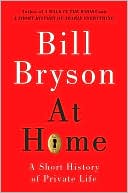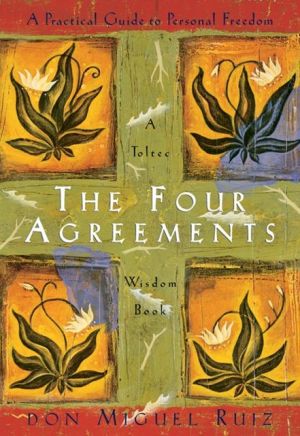Final Exits: The Illustrated Encyclopedia of How We Die
To die, kick the bucket, to meet your Maker, dead as a doornail, get whacked, smoked, bite the dust, sleep with the fishes, go six feet under—whatever death is called, it's going to happen. In 1789 Ben Franklin wrote, "In this world nothing is certain but death and taxes." Death remains a certainty. But how do we die? It's the enormous variety of how that enlivens final exits.\ According to death certificates, in 1700 there were less than 100 causes of death. Today there are 3,000. With each...
Search in google:
To die, kick the bucket, to meet your Maker, dead as a doornail, get whacked, smoked, bite the dust, sleep with the fishes, go six feet under—whatever death is called, it's going to happen. In 1789 Ben Franklin wrote, "In this world nothing is certain but death and taxes." Death remains a certainty. But how do we die? It's the enormous variety of how that enlivens final exits.According to death certificates, in 1700 there were less than 100 causes of death. Today there are 3,000. With each advance of technology, people find new ways to become deceased, often causing trends that peak in the first year. People are now killed by everything, from cell phones, washing machines, lawn mowers and toothpicks, to the boundless catalog of man—made medicines. In Final Exits the causes of death—bizarre or common—are alphabetically arranged and include actual accounts of people, both famous and ordinary, who unfortunately died that way. (Ants, bad words, Bingo, bean bag chairs, flying cows, frozen toilets, hiccups, lipstick, moray eels, road kill, starfish, and toupees are only some of the more unusual causes.)
\ \ Final Exits\ \ \ \ The Illustrated Encyclopedia of How We Die\ \ \ \ By Michael Largo\ \ \ HarperCollins Publishers, Inc.\ \ \ \ Copyright © 2006\ \ Michael Largo\ All right reserved.\ \ ISBN: 0060817410\ \ \ Chapter One\ \ \ Every seven seconds a person is born in America.\ Every fourteen seconds a person dies.\ \ \ \ \ Abactio This is a medical term for abortion or premature labor induced by street drugs, herbal concoctions, or homestyle surgery. Regardless of one's opinions about the termination of unwanted pregnancy, the fact remains that it has been done since the onset of civilization. In Roman times, magic potions to dispel pregnancy were openly sold at market and persons knowledgeable about the theurgy of miscarriage were hired to recite incantations near a woman's swelling stomach. In the Middle Ages, the use of emetics, pastes, and physical maneuvers to stop pregnancy were described in detail in medical literature (based on the translated writings of Galen, a Greek physician, circa a.d. 200) and used since the first medical school was founded in Salerno, Italy, in the eighth century.\ Emma Goldman, a writer and human right's activist noted that, throughout history, prior to education and contraception, "Most women lived in continual dread of conception." For many wives of the late nineteenth and early twentieth centuries, getting pregnant was seen as a possible death sentence for either themselves or their unborn children.\ For many women abortion wassimply the most reliable form of contraception. To rid themselves of another pregnancy, women would massage their stomachs vigorously, jump off tables, throw themselves down flights of stairs and, when all else failed, resorted to the use of blunt instruments. Between 1850 and 1930 physicians and midwives offered a variety of remedies for "obstructed menses," prescribing recipes for mixtures often as lethal to the mother as it was to the embryo. Although it was illegal to sell or advertise contraception devices, the sale of these potions or "abortifacients" was acceptable.\ In 1900 there were one hundred thousand abortions performed in New York City, and 17,300 deaths as a result of those procedures. Today, 1.3 million abortions are performed in the United States each year. Drug overdoses by girls under eighteen years old and "homestyle" abortions initiated by parents account for four thousand such terminations and 710 deaths, annually. However, those wishing to give up a child for adoption have to run a gauntlet of red tape and face ostracism. In 2003, U.S. couples adopted 20,099 children from other countries.\ \ \ \ Death of mothers from illegal abortions from 1988 to 2004: 12,206\ Death of mothers from legal abortions since 1988: 109\ \ \ \ \ Abandonment in Cars In March 2001, a Texas mother left her five-month-old baby in his car seat while she went to work at a nearby restaurant. She reported to work at 10:00 a.m. and returned to the car at 3:00 p.m. She found the infant lifeless. During the day the heat inside the car had risen to 100°F. The distraught woman told police she must have forgotten to drop her baby off at the day care center.\ In 2004, 298 children died when they were left alone in hot automobiles. According to a survey conducted by the National Safe Kids Campaign in 2002, ten thousand parents said they regularly leave children inside a running car for at least three minutes while attending errands. Although only one hundred admitted to leaving the child in a car for thirty minutes or more, children left in unattended vehicles is becoming quite common. One woman confessed to leaving her three-year-old unaccompanied in a car for up to four hours each day because she had no access to child care. She would keep the window slightly open, park the car within sight of her office window, and provide the child with drinks and toys. However, during an exceptional hot August day in 2004, the child died of heatstroke.\ \ \ \ Fatalities of children in unattended vehicles since 1985: 2,780\ \ \ \ \ Acordynia Most people know mercury as the toxic shiny, silver white, liquid metal, sometimes dyed red and seen in a thermometer; they figure as long as they don't come into contact with the stuff they have no chance of getting, and dying from, acordynia--mercury poisoning. However, mercury is found in hundreds of common things we use everyday from washing machines to motion-sensitive devices in your freezer, sump pumps, space heaters, and irons. The substance also is used in fluorescent and vapor lamps and in neon signs.\ Power plants account for one-third (52 tons) of annual man-made mercury emissions in the country. All of these mercury vapors are easily transported through the atmosphere to land and water. Mercury is very soluble in water and gets quickly absorbed into the plankton levels of the food chain. It passes from little fish to big fish to us, virtually undiluted. That's why eating too much predator fish, such as swordfish, shark, and even canned tuna, causes mercury poisoning.\ \ \ \ 6,530 people are hospitalized and five hundred die from mercury poisoning each year.\ \ \ \ \ Ague Genealogy buffs come across this cause of death so often, but we never hear of it in current times. By definition, "Ague"--pronounced EE-Goo--means chills, shakes, and fevers and according to old-time doctors, everyone died of it. Before 1920, a plethora of death certificates showed this as a cause. Back then it apparently made doctors appear very knowledgeable, especially when they didn't know exactly what was happening to the patient: "I'm sorry, his EE-Goo is too far advanced." It must have seemed more professional to ascribe a cause of death instead of the vague "malady," "unwellness," or "unknown sickness." Since then, at least five hundred diseases have been differentiated from this onetime catch-all killer--everything from an ordinary infection, or an abscessed tooth, to yellow fever. By looking at how the diagnosis of ague changed over the centuries, it's clear to see how science has advanced.\ \ \ \ Ague was recorded on 319,334 death certificates from 1850 to 1920. (See Also: Postmortem/Death Certificates)\ \ \ \ \ Air Shows Who doesn't love the roar of the jets and death-defying aerobatics? The last fatal performance in North America, in 1952, when twenty-eight in the audience died, prompted the initiation of a one thousand . . .\ \ \ Continues...\ \ \ \ \ \ \ Excerpted from Final Exits\ by Michael Largo\ Copyright © 2006 by Michael Largo.\ Excerpted by permission.\ All rights reserved. No part of this excerpt may be reproduced or reprinted without permission in writing from the publisher.\ Excerpts are provided by Dial-A-Book Inc. solely for the personal use of visitors to this web site.\ \ \
\ From Barnes & NobleWe're finding new ways to die: In the 18th centuries, experts were able to count less than 100 causes of death. Today, the tally tops 3,000. Potential culprits are everywhere: cell phones, washing machines, lipstick, rare infectious diseases, building materials, even tainted medicine. Michael Largo's Final Exits catalogues the seemingly countless ways that men and women leave this mortal coil. Skillfully avoiding the macabre, Largo provides fascinating stories and statistics on common and uncommon demises. The book contains numerous sidebars, including a top ten list of causes of death, famous last words, burial customs, and much more. An unavoidable topic treated in the best possible way.\ \ \ \ \ Daniel Handler"Every mortal should read this book, before they find themselves in its pages."\ \








